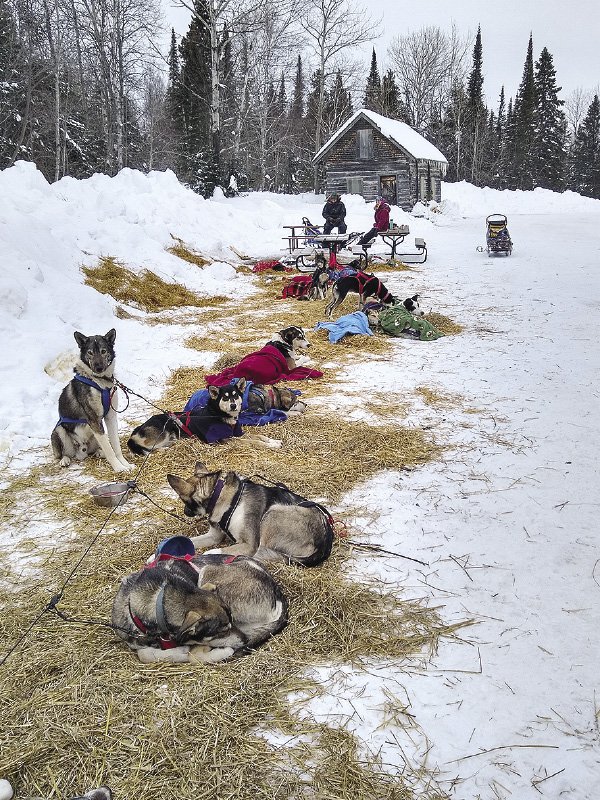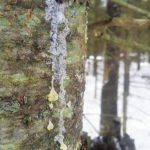We are a week away from running the UP 200, a 250-mile race in the Upper Peninsula of Michigan that runs from downtown Marquette through a screaming mob of yoopers ringing cow bells, along the shores of Superior and into a twisty-turny network of trails that eventually shoots out in Grand Marais, Michigan. The course then returns over the same path, bringing teams back to Marquette two days after the race began.
In the past few weeks between the Gunflint Mail Run and now, we have attempted to keep the dogs “trained up” by running 25-50 miles at a time, almost every other day. After any training run, Matt and I check in on how the run went. What we really want to know is who did well and who didn’t, and by this we really mean, whose tugline was tight?
The reality of training a team for long-distance racing is that we spend a lot of time, and I mean hours upon hours, watching dogs run from behind. We watch their feet—I can tell you what gait each dog in the kennel prefers (Itsy lopes 75 percent of the time and when she isn’t loping, she is trotting. Dells only trots. Maybe, in the very beginning of a run, she’ll lope as we break from the kennel and go cruising down the first mile of plowed road, but after that, it’s a trot. Tom has a pace gait where the paws on the right move together and the paws on the left move together—it’s a bit of an awkward gait and makes his butt wag back and forth). If a dog changes their gait, something’s up, usually a sore muscle or injury.
More than anything else, we watch tuglines. A tugline connects the dog’s harness to the gangline. It is two to three feet long. A tugline should be taut, and by taut, I mean no slack. If a dog is truly pulling, their harness and tug right back to the gangline is straight and even. A tug that is even a little slack bounces around.
When Matt and I checked in after a recent training run, I reported that Pinto was off. His tugline was slack for most of the run. This is not his norm. Something must be wrong. We look him over, stretch him out. Nothing obvious arises. The next run we booty his four paws and he’s back to 90 percent. Sometimes it’s a matter of moving a dog around in the team—maybe he is intimidated by his neighbor, maybe the harness we are using isn’t the right size, maybe she is bored of our trails or doesn’t like running during the day. It can be any of 100 things and it is our job as team coach to figure out the problem. Any dog on the race team should be pulling more than 80 percent of the time.
The UP200 is a 12-dog race and we have 14 dogs trained for these 12 spots. We are constantly trying to determine which 12 should be on the team, and I think we have it narrowed down, but we will see if a recent wrist injury heals up in time for the race. If not, Hush or Stevie, the alternates will step up to the plate. We will leave for the UP with 14 dogs, because after the race, I will drive the dogs east to New Hampshire, spend a week training at my friend Sally Manikian’s kennel, pick up Matt and our daughter Sylvia at the airport in Portland and then continue on to the Can-Am race in the mountains of northern Maine, a 250-mile unassisted race.
Preparations for three weeks of road trip with 14 dogs looks like this: chop 350 pounds of frozen meat into 10-pound chunks. Sort, count and pack all the booties we own, six bags of kibble, dog coats and blankets, car snacks, and dog bowls. Fix the heater in the dog trailer, put new tires on the dog trailer, sew up the sled bag that some dog chewed up last year. Replace the missing bolts on the sled brake. Write instructions for the kennel sitter.
Despite the long to-do list, we find ourselves excited for the upcoming trip to Marquette. Returning to the races we have been running for years now feels comforting—the nerves I used to experience have dissipated somewhat as the many unknowns of racing have become more predictable. We have our Marquette routine now and I know the ins and outs of the race checkpoints, including the much-anticipated pie table in Grand Marais. Sylvia and Grandma Vicki will come along to cheer on the team.
And thus the 2019/2020 mushing season feels like it is nearing the end, even though the two big races that we have trained for are still ahead. After that it’s fun runs and puppy training until the snow recedes…but then, there is a lot of snow out there, so perhaps there is plenty of mushing season ahead.




